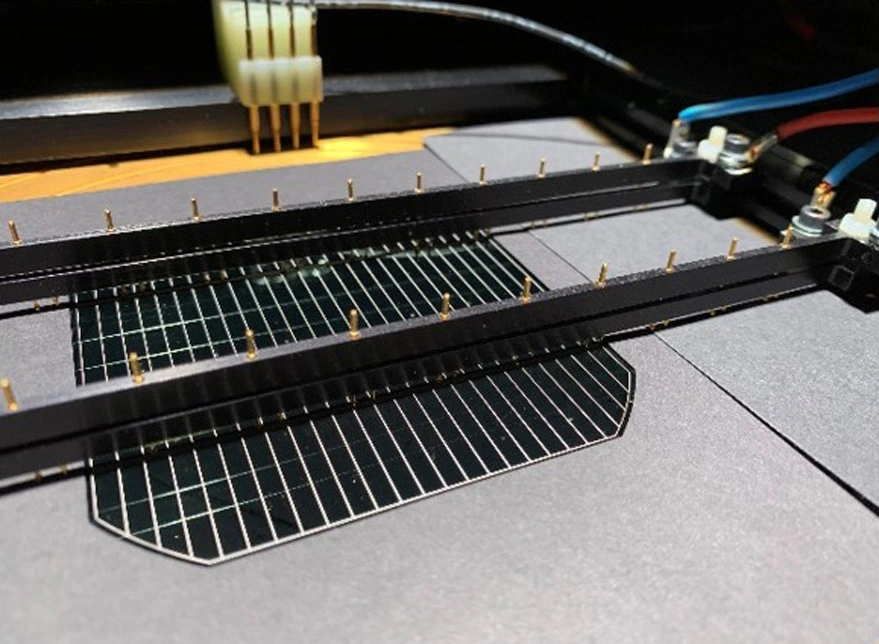Production facilities for silicon-perovskite tandem solar cells at Helmholtz-Zentrum
New facilities pave the way for industrial-scale production
Perovskites are regarded as promising materials for solar cells, able to be manufactured at low cost while at the same time being extremely efficient. They are particularly suitable for tandem solar cells that combine a cell made of silicon and one of perovskite. As a result, sunlight is more completely used when generating electrical energy. So far, the advantages of such cells have only been available for use at small laboratory scale. With two new, highly innovative production facilities, researchers at the Helmholtz-Zentrum Berlin für Materialien und Energie (HZB) are now creating the basis for future production on an industrial scale.
Solar cells made of perovskite materials have undergone unprecedented development. Just a few years ago, they could only achieve meagre energy yields with efficiencies of around 10 per cent. Today, the latest cells impressively provide more than twice this efficiency. Research groups at the HZB have been instrumental in this rapid and considerable improvement in cell characteristics. For example, a Helmholtz Young Investigator Group headed by Prof. Steve Albrecht holds the current world efficiency record of 29.1 per cent for tandem solar cells made of perovskite and silicon.
In tandem for higher energy yield
This novel type of tandem solar cell consists of a silicon cell and a second, superposed cell based on a semiconductor compound with a perovskite structure. The advantage of combining different materials is that their absorption spectra complement each other. The wavelengths of sunlight that silicon makes poor use of can be converted into significantly more electrical energy using suitable – and inexpensive to produce – perovskite compounds. Tandem solar cells can thus considerably exceed the physical efficiency limit of 29.4 per cent that silicon solar cells exhibit today.
“Our goal is to increase the efficiency of these novel cells to more than 30 percent – not only at laboratory scale, but also when produced on a commercial scale“, says Prof. Bernd Stannowski, who is heading the work on this at the Competence Centre Photovoltaics Berlin (PVcomB) of the HZB. “Together with Steve Albrecht's team, we are focussing on new modular systems that will raise the fabrication scale of silicon-perovskite tandem solar cells to a level appropriate for industry”, the scientist sets out. “This will make it possible to produce tandem cells on 6-inch wafers, as commonly used in the photovoltaic industry”.
For the lower part of the tandem solar cell, known as the bottom cell, a silicon heterojunction is the structure of choice, in which the surfaces of the silicon wafer are provided with very thin amorphous-silicon contact layers. These are produced by plasma-enhanced chemical vapour deposition(PECVD). For this purpose, HZB researchers now have a cluster facility from the Swiss company Indeotec at their disposal. The equipment features an engineering novelty: “As the first system of its kind in the world, it has what is known as PECVD-Mirror process modules with which silicon wafers can be coated on both sides – without having to flip them”, says Stannowski.
The bottom cell produced in this way serves as the basis for further processing into a tandem solar cell, and the HZB team in the Hybrid Silicon-Perovskite Research, Integration & Novel Technologies laboratory (HySPRINT) will be able to use a new vacuum deposition system for various materials to conduct research into hybrid silicon-perovskite structures, financed by the German Federal Ministry for Economic Affairs and Energy beginning in 2021. The new system is being developed by the two Dresden-based companies von Ardenne and Creaphys specifically for this purpose. The recently ordered facility will integrate all necessary process steps for fabricating the top cell made of perovskite.
“Using this unique technology, the complete cell consisting of several layers including the electrical contacts will be able to be produced automatically and at high throughput“, emphasises Stannowski. He is convinced that this will bring commercial use of silicon-perovskite tandem solar cells a big step closer.
Contact
Helmholtz-Zentrum Berlin für Materialien und Energie
Prof. Dr. Bernd Stannowski
Institute Competence Centre Photovoltaics Berlin (PVcomB)
Phone: +49 30 8062-15491
Email: bernd.stannowski(at)helmholtz-berlin.de
Prof. Dr. Steve Albrecht
Young Investigator Group Perowskite Tandem Solar Cells
Phone: +49 30 8062-41334
Email: steve.albrecht(at)helmholtz-berlin.de
Press Officer
Dr. Ina Helms
Phone: +49 30 8062-42034 / -14626
Email: ina.helms(at)helmholtz-berlin.de
Press release HZB, 7 September 2020
